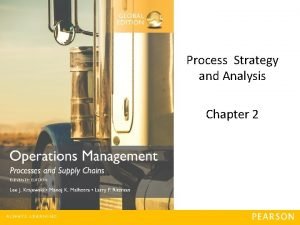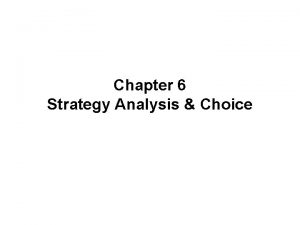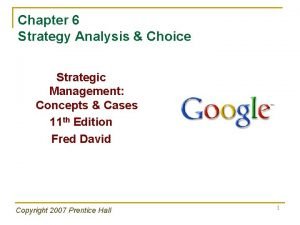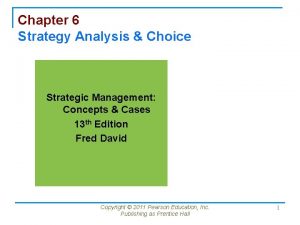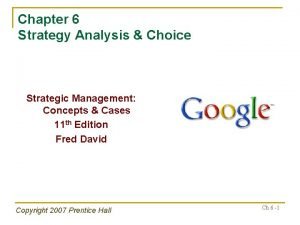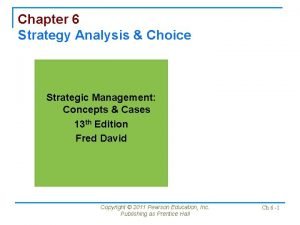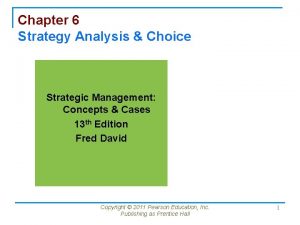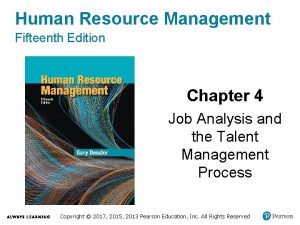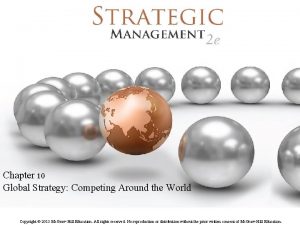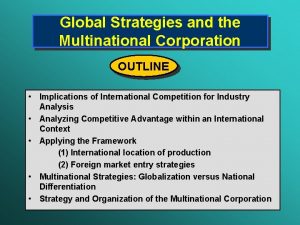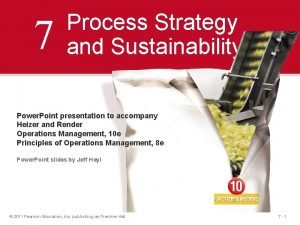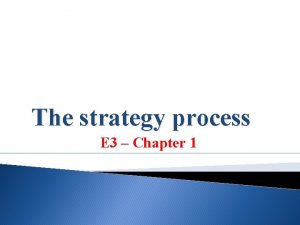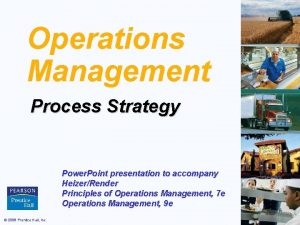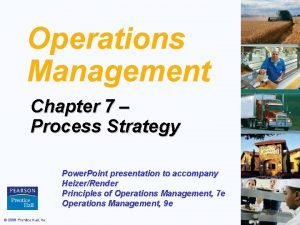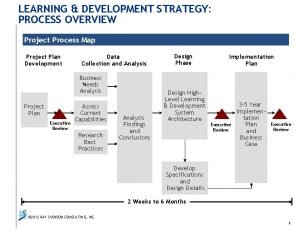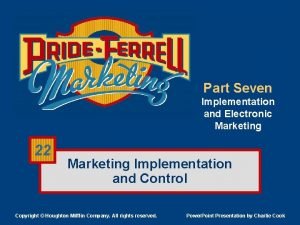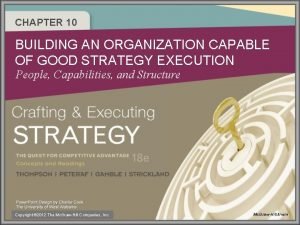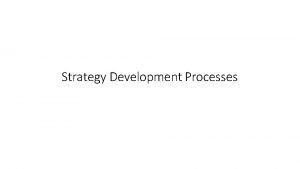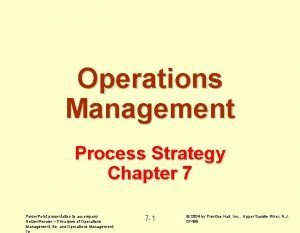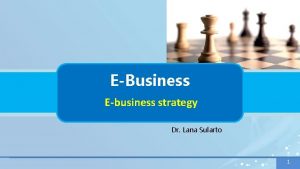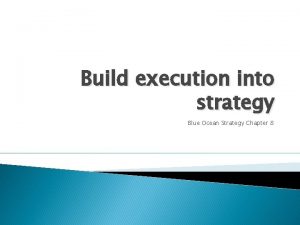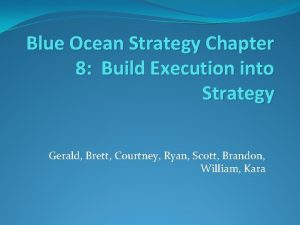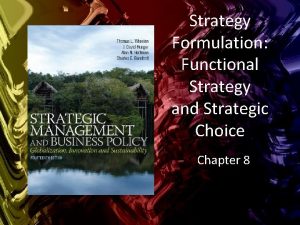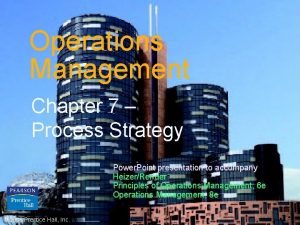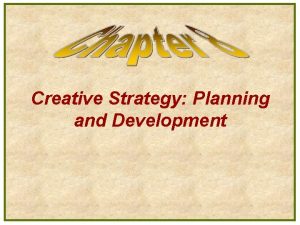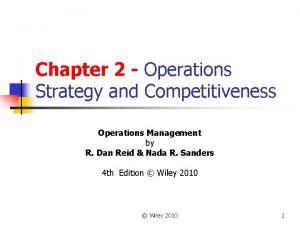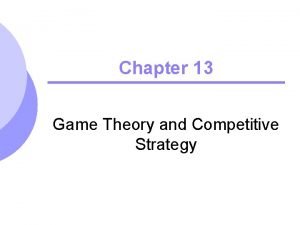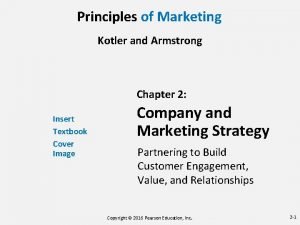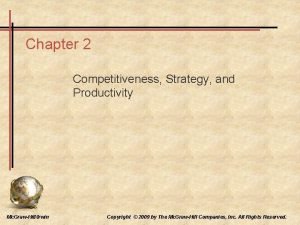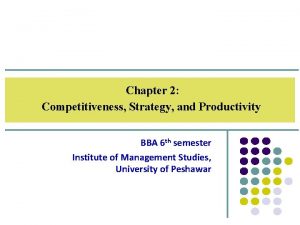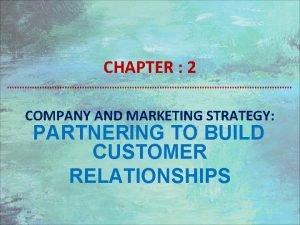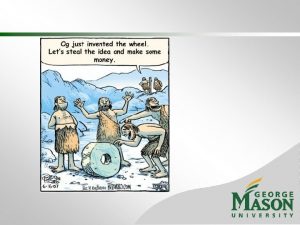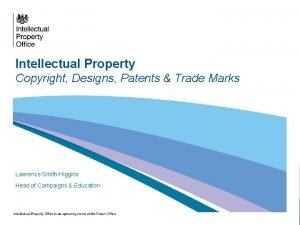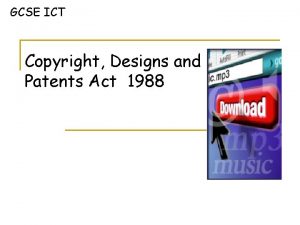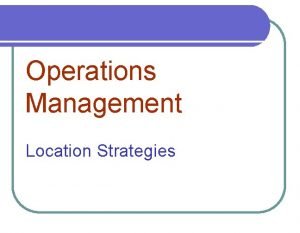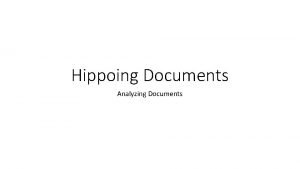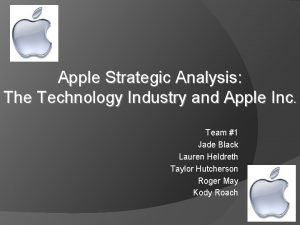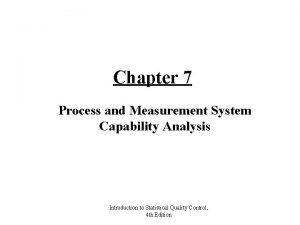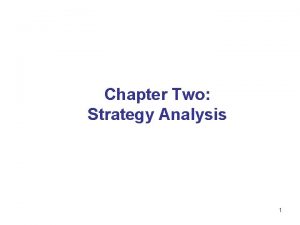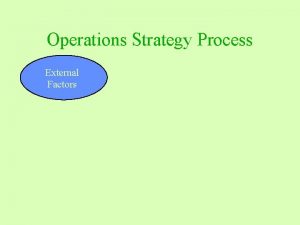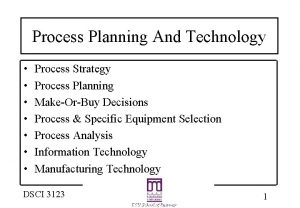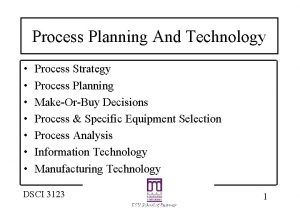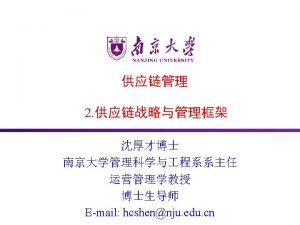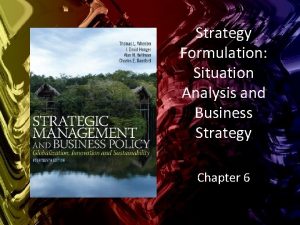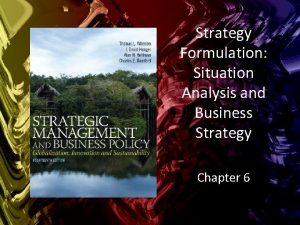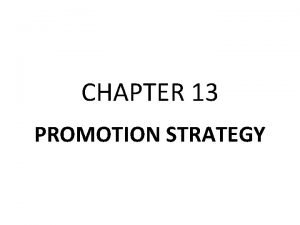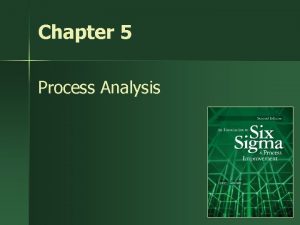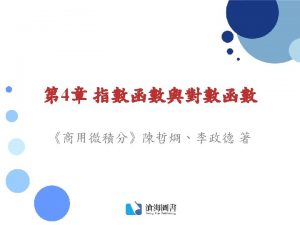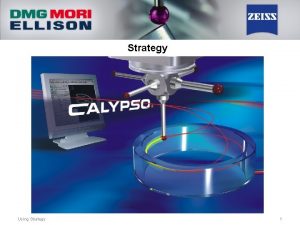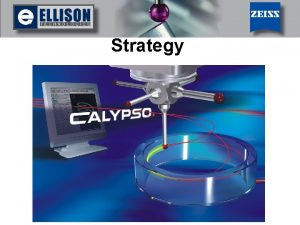Process Strategy and Analysis Chapter 2 Copyright 2016































































- Slides: 63

Process Strategy and Analysis Chapter 2 Copyright © 2016 Pearson Education, Limited. 2 -

What is Process Strategy? Process Strategy The pattern of decisions made in managing processes so that they will achieve their competitive priorities Copyright © 2016 Pearson Education, Limited. 2 -2

Process Strategy Figure 2. 1 Copyright © 2016 Pearson Education, Limited. 2 -3

Process Structure in Services DIMENSIONS OF CUSTOMER CONTACT IN SERVICE PROCESSES Dimension High Contact Low Contact Physical presence Present Absent What is processed People Possessions or information Contact intensity Active, visible Passive, out of sight Personal attention Personal Impersonal Method of delivery Face-to-face Regular mail or e-mail Table 2. 1 Copyright © 2016 Pearson Education, Limited. 2 -4

Process Structure in Services • Customer Contact – The extent to which the customer is present, is actively involved, and receives personal attention during the service process • Customization – Service level ranging from highly customized to standardized • Process Divergence – The extent to which the process is highly customized with considerable latitude as to how its tasks are performed • Flow – How the work progresses through the sequence of steps in a process Copyright © 2016 Pearson Education, Limited. 2 -5

Customer-Contact Matrix Figure 2. 2 Copyright © 2016 Pearson Education, Limited. 2 -6

Service Process Structuring • Front Office • Hybrid Office • Back Office Copyright © 2016 Pearson Education, Limited. 2 -7

Process Structure in Manufacturing • Process Choice – A way of structuring the process by organizing resources around the process or organizing them around the products. Copyright © 2016 Pearson Education, Limited. • Job Process • Batch Process – Small or Large • Line Process • Continuous-Flow 2 -8

Process Structure in Manufacturing Figure 2. 3 Copyright © 2016 Pearson Education, Limited. 2 -9

Production and Inventory Strategies • Design-to-Order • Make-to-Order • Assemble-to-Order – Postponement – Mass Customization • Make-to-Stock – Mass Production Copyright © 2016 Pearson Education, Limited. 2 -10

Layout • Layout - The physical arrangement of operations (or departments) relative to each other – Operation - A group of human and capital resources performing all or part of one or more processes Copyright © 2016 Pearson Education, Limited. 2 -11

Process Strategy Decisions • Customer Involvement • Resource Flexibility • Capital Intensity Copyright © 2016 Pearson Education, Limited. 2 -12

Customer Involvement • Possible Advantages – Increased net value to the customer – Better quality, faster delivery, greater flexibility, and lower cost – Reduction in product, shipping, and inventory costs – Coordination across the supply chain Copyright © 2016 Pearson Education, Limited. 2 -13

Customer Involvement • Possible Disadvantages – Can be disruptive – Managing timing and volume can be challenging – Quality measurement can be difficult – Requires interpersonal skills – Multiple locations may be necessary Copyright © 2016 Pearson Education, Limited. 2 -14

Resource Flexibility • Workforce – Flexible workforce • Equipment – General-purpose – Special-purpose Figure 2. 4 Copyright © 2016 Pearson Education, Limited. 2 -15

Application 2. 1 BBC is deciding whether to weld bicycle frames manually or to purchase a welding robot. If welded manually, investment costs for equipment are only $10, 000. The per-unit cost of manually welding a bicycle frame is $50. 00 per frame. On the other hand, a robot capable of performing the same work costs $400, 000. Robot operating costs including support labor are $20. 00 per frame. Fixed costs Variable costs Welded manually Welded by robot (Make) (Buy) $10, 000 $400, 000 $50 $20 At what volume would BBC be indifferent to these alternative methods? Q = Fm – Fb b $10, 000 – $400, 000 =c $20 – $50 = 13, 000 frames – cm Copyright © 2016 Pearson Education, Limited. 2 -16

Capital Intensity • Automating Manufacturing Processes – Fixed Automation – Flexible (Programmable) Automation • Automating Service Processes • Economies of Scope Copyright © 2016 Pearson Education, Limited. 2 -17

Decision Patterns for Manufacturing Processes Figure 2. 5 Copyright © 2016 Pearson Education, Limited. 2 -18

Gaining Focus • Focus by Process Segments – Plant within plants (PWPs) • Different operations within a facility with individualized competitive priorities, processes, and workforces under the same roof. – Focused Service Operations – Focused Factories • The result of a firm’s splitting large plants that produced all the company’s products into several specialized smaller plants. Copyright © 2016 Pearson Education, Limited. 2 -19

Process Reengineering • Reengineering – The fundamental rethinking and radical redesign of processes to improve performance dramatically in terms of cost, quality, service, and speed Copyright © 2016 Pearson Education, Limited. 2 -20

Process Reengineering • Key elements – Critical processes – Strong leadership – Cross-functional teams – Information technology – Clean-slate philosophy – Process analysis Copyright © 2016 Pearson Education, Limited. 2 -21

Process Improvement • Process Improvement – The systematic study of the activities and flows of each process to improve it Copyright © 2016 Pearson Education, Limited. 2 -22

What is Process Analysis? Process Analysis The documentation and detailed understanding of how work is performed and how is can be redesigned Copyright © 2016 Pearson Education, Limited. 2 -23

Six Sigma Process Improvement Model Figure 2. 6 Copyright © 2016 Pearson Education, Limited. 2 -24

Documenting and Evaluating the Process • Flowcharts • Work Measurement Techniques • Process Charts Copyright © 2016 Pearson Education, Limited. 2 -25

Documenting and Evaluating the Process Flowchart – A diagram that traces the flow of information, customers, equipment, or materials through the various steps of a process Service Blueprint – A special flowchart of a service process that shows which steps have high customer contact Copyright © 2016 Pearson Education, Limited. 2 -26

Swim Lane Flowchart – A visual representation that groups functional areas responsible for different sub-processes into lanes. Figure 2. 7 Copyright © 2016 Pearson Education, Limited. 2 -27

Documenting and Evaluating the Process • Work Measurement Techniques – Time Study – Elemental Standard Data approach – Predetermined Data Approach – Work Sampling Method – Learning Curve Analysis Copyright © 2016 Pearson Education, Limited. 2 -28

Example 2. 1 A process at a watch assembly plant has been changed. The process is divided into three work elements. A time study has been performed with the following results. The time standard for process previously was 14. 5 minutes. Based on the new time study, should the time standard be revised? Copyright © 2016 Pearson Education, Limited. 2 -29

Example 2. 1 • The new time study had an initial sample of four observations, with the results shown in the following table. The performance rating factor (RF) is shown for each element, and the allowance for the whole process is 18 percent of the total normal time. Average (min) RF Normal Time 2. 86 2. 730 1. 0 2. 730 5. 10 4. 68 4. 875 1. 1 5. 363 2. 13 2. 25 2. 135 0. 9 1. 922 Obs 1 Obs 2 Obs 3 Obs 4 Element 1 2. 60 2. 34 3. 12 Element 2 4. 94 4. 78 Element 3 2. 18 1. 98 Total Normal Time = 10. 015 Copyright © 2016 Pearson Education, Limited. 2 -30

Example 2. 1 The normal time for an element in the table is its average time, multiplied by the RF. The total normal time for the whole process is the sum of the normal times for the three elements, or 10. 01 minutes. To get the standard time (ST) for the process, just add in the allowance, or ST = 10. 015(1 + 0. 18) = 11. 82 minutes/watch Yes, change the time standard from 14. 5 minutes to 11. 82 minutes. Copyright © 2016 Pearson Education, Limited. 2 -31

Work Measurement Techniques • Work Sampling Documenting and Evaluating the Process Figure 2. 8 Copyright © 2016 Pearson Education, Limited. 2 -32

Work Measurement Techniques • Learning Curves Figure 2. 9 Copyright © 2016 Pearson Education, Limited. 2 -33

Process Charts • Process Charts - An organized way of documenting all the activities performed by a person or group, at a workstation, with a customer, or working with certain materials • Activities are typically organized into five categories – Operation, – Transportation, – Inspection, – Delay, – Storage, Copyright © 2016 Pearson Education, Limited. 2 -34

Process Charts Step No. Figure 2. 10 Time (min) Distance (ft) 1 0. 50 15. 0 2 10. 00 3 0. 75 4 3. 00 5 0. 75 6 1. 00 7 1. 00 8 4. 00 9 5. 00 10 2. 00 11 3. 00 12 2. 00 13 3. 00 14 2. 00 15 1. 00 16 4. 00 17 2. 00 18 4. 00 19 1. 00 X Enter emergency room, approach patient window Sit down and fill out patient history X Nurse escorts patient to ER triage room X 40. 0 Nurse inspects injury X Return to waiting room X 60. 0 X X Nurse takes patient to radiology X Technician x-rays patient X Return to bed in ER X X 60. 0 X Copyright © 2016 Pearson Education, Limited. Return to emergency entrance area Check out X X 20. 0 Wait for doctor to return Doctor provides diagnosis and advice X 180. 0 Wait for doctor Doctor inspects injury and questions patient X 200. 0 Wait for available bed Go to ER bed X 200. 0 Step Description Walk to pharmacy Pick up prescription X Leave the building 2 -35

Process Charts Step No. Figure 2. 10 Time (min) Distance (ft) 1 0. 50 15. 0 2 10. 00 3 0. 75 4 3. 00 5 0. 75 6 1. 00 7 1. 00 8 4. 00 9 5. 00 10 2. 00 11 3. 00 12 2. 00 13 3. 00 14 2. 00 15 1. 00 16 4. 00 17 2. 00 18 4. 00 19 1. 00 Activity X X Operation X 40. 0 X 60. 0 X Transport Inspect X Delay X X Store X 200. 0 X X Nurse inspects injury 9 11. 00 815 Return to waiting room 8. 00 available 2 bed Wait for Go to ER bed 3 8. 00 Wait for doctor ― and questions ― inspects injury Doctor patient 5 to ER triage 23. 00 room Nurse escorts patient Wait for doctor to return Return to emergency entrance area Check out X X Copyright © 2016 Pearson Education, Limited. Sit down and fill out patient history Doctor provides diagnosis and advice X 180. 0 Distance (ft) Return to bed in ER X 60. 0 Time (min) Technician x-rays patient X 200. 0 Number of Steps Enter emergency room, approach patient window Nurse takes patient to radiology X 20. 0 Summary Step Description Walk to pharmacy Pick up prescription X Leave the building 2 -36

Process Charts • The annual cost of an entire process can be estimated • It is the product of 1) Time in hours to perform the process each time 2) Variable costs per hour 3) Number of times the process is performed each year Annual labor cost = Time to perform the process in hours Copyright © 2016 Pearson Education, Limited. Variable costs Number of times process per hour performed each year 2 -37

Process Charts • If the average time to serve a customer is 4 hours • The variable cost is $25 per hour • And 40 customers are served per year • The total labor cost is 4 hrs/customer $25/hr 40 customers/yr = $4, 000 Copyright © 2016 Pearson Education, Limited. 2 -38

Data Analysis Tools • • • Checklists Histograms and Bar Charts Pareto Charts Scatter Diagrams Cause-and-Effect Diagrams (Fishbone) Graphs Copyright © 2016 Pearson Education, Limited. 2 -39

Example 2. 2 The manager of a neighborhood restaurant is concerned about the smaller numbers of customers patronizing his eatery. Complaints have been rising, and he would like to find out what issues to address and present the findings in a way his employees can understand. The manager surveyed his customers over several weeks and collected the following data: Complaint Discourteous server Slow service Cold dinner Cramped table Atmosphere Copyright © 2016 Pearson Education, Limited. Frequency 12 42 5 20 10 2 -40

Failures Example 2. 2 50 – 45 – 40 – 35 – 30 – 25 – 20 – 10 – 5– 0– Discourteous server Slow service Cold dinner Cramped tables Atmosphere Failure Name Bar Chart Figure 2. 11 Copyright © 2016 Pearson Education, Limited. 2 -41

Example 2. 2 (42 + 20) 100% = 69. 7% 89 40 – – 80. 0% Failures 35 – 30 – – 60. 0% 25 – – 40. 0% 20 – 10 – – 20. 0% 5– 0– Percent of Total – 100. 0% 45 – din Cold ne r ere osp h Atm Dis cou rte ser ous ver m tab ped les Cra ser Slow vic e – 0. 0% Failure Name Figure 2. 12 Copyright © 2016 Pearson Education, Limited. Pareto Chart 2 -42

Example 2. 3 A process improvement team is working to improve the production output at the Johnson Manufacturing plant’s Header Cell that manufactures a key component, headers, used in commercial air conditioners. Currently the header production cell is scheduled separately from the main work in the plant. Copyright © 2016 Pearson Education, Limited. 2 -43

Example 2. 3 • The team conducted extensive on-site observations across the six processing steps within the cell and they are as follows: 1. Cut copper pipes to the appropriate length 2. Punch vent and sub holes into the copper log 3. Weld a steel supply valve onto the top of the copper log 4. Braze end caps and vent plugs to the copper log 5. Braze sub tubes into each stub hole in the copper log 6. Add plastic end caps to protect the newly created header Copyright © 2016 Pearson Education, Limited. 2 -44

Example 2. 3 • To analyze all the possible causes of that problem, the team constructed a cause-andeffect diagram. • Several suspected causes were identified for each major category. Copyright © 2016 Pearson Education, Limited. 2 -45

Example 2. 3 Figure 2. 13 Copyright © 2016 Pearson Education, Limited. 2 -46

Example 2. 4 The Wellington Fiber Board Company produces headliners, the fiberglass components that form the inner roof of passenger cars. Management wanted to identify which process failures were most prevalent and to find the cause. Step 1: A checklist of different types of process failures is constructed from last month’s production records. Step 2: A Pareto chart is prepared from the checklist data. Step 3: A cause-and-effect diagram identified several potential causes for the problem. Step 4: The manager reorganizes the production reports into a bar chart according to shift because the personnel on the three shifts had varied amounts of experience. Copyright © 2016 Pearson Education, Limited. 2 -47

Example 2. 4 Checklists Pareto Chart Figure 2. 14 Copyright © 2016 Pearson Education, Limited. 2 -48

Example 2. 4 Cause-and-Effect Diagram Bar Chart Figure 2. 14 Copyright © 2016 Pearson Education, Limited. 2 -49

Redesigning and Managing Process Improvements • Questioning and Brainstorming • Benchmarking • Implementing Copyright © 2016 Pearson Education, Limited. 2 -50

Redesigning and Managing Process Improvements • Questioning and Brainstorming • Ideas can be uncovered by asking six questions 1. 2. 3. 4. 5. 6. What is being done? When is it being done? Who is doing it? Where is it being done? How well does it do on the various metrics of importance? Copyright © 2016 Pearson Education, Limited. 2 -51

Redesigning and Managing Process Improvements • Benchmarking – A systematic procedure that measures a firm’s processes, services, and products against those of industry leaders Copyright © 2016 Pearson Education, Limited. 2 -52

Redesigning and Managing Process Improvements • Implementing – Avoid the following seven mistakes 1. Not connecting with strategic issues 2. Not involving the right people in the right way 3. Not giving the design teams and process analysts a clear charter, and then holding them accountable 4. Not being satisfied unless fundamental “reengineering” changes are made 5. Not considering the impact on people 6. Not giving attention to implementation 7. Not creating an infrastructure for continuous process improvement Copyright © 2016 Pearson Education, Limited. 2 -53

Solved Problem 1 Create a flowchart for the following telephone-ordering process at a retail chain that specializes in selling books and music CDs. It provides an ordering system via the telephone to its time-sensitive customers besides its regular store sales. The automated system greets customers, asks them to choose a tone or pulse phone, and routes them accordingly. The system checks to see whether customers have an existing account. They can wait for the service representative to open a new account. Customers choose between order options and are routed accordingly. Customers cancel the order. Finally, the system asks whether the customer has additional requests; if not, the process terminates. Copyright © 2016 Pearson Education, Limited. 2 -54

Solved Problem 1 Figure 2. 16 Copyright © 2016 Pearson Education, Limited. Continued on Next Slide 2 -55

Solved Problem 1 Figure 2. 16 Copyright © 2016 Pearson Education, Limited. 2 -56

Solved Problem 2 An automobile service is having difficulty providing oil changes in the 29 minutes or less mentioned in its advertising. You are to analyze the process of changing automobile engine oil. The subject of the study is the service mechanic. The process begins when the mechanic directs the customer’s arrival and ends when the customer pays for the services. The times add up to 28 minutes, which does not allow much room for error if the 29 -minute guarantee is to be met and the mechanic travels a total of 420 feet. Copyright © 2016 Pearson Education, Limited. 2 -57

Step No. Time (min) Distance (ft) 1 0. 80 50. 0 2 1. 80 3 2. 30 4 0. 80 5 0. 60 6 0. 70 7 0. 90 8 1. 90 9 0. 40 10 0. 60 11 4. 20 12 0. 70 13 2. 70 14 1. 30 15 0. 50 16 1. 00 17 3. 00 18 0. 70 19 0. 30 20 0. 50 21 2. 30 X Direct customer into service bay Record name and desired service Summary X X 0. 30 Open hood, verify engine type, inspect hoses, check fluids Number Time Distance Activity. Walk to customer in waiting area of Steps (min) (ft) X X Recommend additional services X 70. 0 X X X 50. 0 X X 40. 0 X 7 16. 50 8 5. 50 Transport Walk to storeroom Look up filter number(s) 4 5. 00 Inspect Check filter number(s) 0. 70 Delay Carry filter(s) to service 1 pit Perform under-car services 1 0. 30 Store Climb from pit, walk to automobile Operation Wait for customer decision X Inspect for leaks X Walk to pit X Inspect for leaks X 80. 0 Clean and organize work area X Return to auto, drive from bay X 60. 0 X X 420 Fill engine with oil, start engine X 40. 0 Step Description Park the car Walk to customer waiting area Total charges, receive payment Figure 2. 17 Copyright © 2016 Pearson Education, Limited. 2 -58

Solved Problem 3 What improvement can you make in the process shown in Solved Problem 2? a. Move Step 17 to Step 21. Customers should not have to wait while the mechanic cleans the work area. b. Store small inventories of frequently used filters in the pit. Steps 7 and 10 involve travel to and from the storeroom. c. Use two mechanics. Steps 10, 12, 15, and 17 involve running up and down the steps to the pit. Much of this travel could be eliminated. Copyright © 2016 Pearson Education, Limited. 2 -59

Solved Problem 4 Vera Johnson and Merris Williams manufacture vanishing cream. Their packaging process has four steps: (1) mix, (2) fill, (3) cap, and (4) label. They have had the reported process failures analyzed, which shows the following: Defect Lumps of unmixed product Over- or underfilled jars Jar lids did not seal Labels rumpled or missing Total Frequency 7 18 6 29 60 Draw a Pareto chart to identify the vital defects. Copyright © 2016 Pearson Education, Limited. 2 -60

Solved Problem 4 Defective labels account for 48. 33 percent of the total number of defects: 29 100% = 48. 33% 60 Improperly filled jars account for 30 percent of the total number of defects: 18 100% = 30. 00% 60 The cumulative percent for the two most frequent defects is 48. 33% + 30. 00% = 78. 33% Copyright © 2016 Pearson Education, Limited. 2 -61

Solved Problem 4 Lumps represent 7 100% = 11. 67% of defects; 60 the cumulative percentage is 78. 33% + 11. 67% = 90. 00% 6 100% = 10% of defects; Defective seals represent 60 the cumulative percentage is 10% + 90% = 100. 00% Copyright © 2016 Pearson Education, Limited. 2 -62

Solved Problem 4 90% Frequency of Defects 36 – Figure 2. 18 100% – 100 – 90 78% 32 – – 80 28 – – 70 24 – – 60 48% 20 – – 50 16 – – 40 12 – – 30 8– – 20 4– – 10 0– – 0 Label Copyright © 2016 Pearson Education, Limited. Fill Mix Seal Cumulative Percentage of Defects 40 – 2 -63
 The strategy making strategy executing process
The strategy making strategy executing process Process strategy and analysis
Process strategy and analysis New zealand health strategy 2016
New zealand health strategy 2016 Chapter 6 strategy analysis and choice
Chapter 6 strategy analysis and choice Chapter 6 strategy analysis and choice
Chapter 6 strategy analysis and choice Chapter 6 strategy analysis and choice
Chapter 6 strategy analysis and choice Chapter 6 strategy analysis and choice
Chapter 6 strategy analysis and choice Strategy formulation analytical framework
Strategy formulation analytical framework Chapter 6 strategy analysis and choice
Chapter 6 strategy analysis and choice Corporate strategy and business strategy
Corporate strategy and business strategy Chase demand example
Chase demand example Human resource management chapter 4
Human resource management chapter 4 Home replication strategy example
Home replication strategy example Transnational strategy advantages
Transnational strategy advantages Aligning hr strategy with business strategy
Aligning hr strategy with business strategy Cage framework
Cage framework The plan of action that prescribes resource allocation
The plan of action that prescribes resource allocation Listening for specific details top-down or bottom-up
Listening for specific details top-down or bottom-up Concentric growth strategy
Concentric growth strategy International or multinational
International or multinational Process strategy and sustainability
Process strategy and sustainability Strategic human resource
Strategic human resource Tows matrix
Tows matrix The strategy process
The strategy process Repetitive focus strategy
Repetitive focus strategy Four basic process strategies
Four basic process strategies Strategy process map
Strategy process map Marketing strategy formation process
Marketing strategy formation process Recruiting and retaining capable employees does not entail
Recruiting and retaining capable employees does not entail Unrealised strategy
Unrealised strategy Process strategy in operations management
Process strategy in operations management A generic strategy process model
A generic strategy process model Strategy formulation process
Strategy formulation process Blue water strategy
Blue water strategy What is functional strategy
What is functional strategy Cross over charts
Cross over charts Youngs creative process
Youngs creative process Olecranon process vs fossa
Olecranon process vs fossa Condylar and coronoid process of mandible
Condylar and coronoid process of mandible Operations strategy and competitiveness
Operations strategy and competitiveness Competitive operations strategy
Competitive operations strategy Chapter 13 game theory and competitive strategy
Chapter 13 game theory and competitive strategy Principles of marketing pearson slides
Principles of marketing pearson slides The methods and actions taken to accomplish strategies
The methods and actions taken to accomplish strategies Labor productivity example
Labor productivity example Company and marketing strategy chapter 2
Company and marketing strategy chapter 2 Chapter 3 information systems organizations and strategy
Chapter 3 information systems organizations and strategy Relashionship marketing
Relashionship marketing Astro quiz 2019 questions and answers
Astro quiz 2019 questions and answers Astro quiz 2016 questions and answers
Astro quiz 2016 questions and answers Widows and orphans word 2016
Widows and orphans word 2016 Difference between copyright and patent
Difference between copyright and patent What is the copyright designs and patents act 1988
What is the copyright designs and patents act 1988 Design and patents act 1988
Design and patents act 1988 Fair use guidelines for teachers
Fair use guidelines for teachers I the lord of sea and sky copyright
I the lord of sea and sky copyright Apple inc strategic analysis
Apple inc strategic analysis Location strategy in operations management
Location strategy in operations management What is a hipp statement
What is a hipp statement Optic meaning
Optic meaning Apple industry overview
Apple industry overview Whole foods swot analysis
Whole foods swot analysis Algorithm design and analysis process
Algorithm design and analysis process Tolerance ratio
Tolerance ratio

